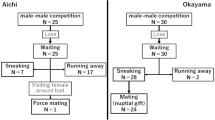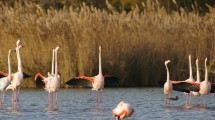Summary
The digger wasp Bembecinus quinquespinosus exhibits characteristics not typical of other species in the family Sphecidae: there is no sexual size dimorphism (Fig. 1) and there is a size-linked color polymorphism among males (Fig. 2). We studied a population of this species in eastern Colorado, USA to determine if the above attributes were related to the male mating strategy.
Data on seasonal changes in sex ratio suggest that this species displays protandry (Fig. 4). Each morning for about a week after they first appear, large numbers of males congregate in the emergence area and search for pre-emergent females. Upon locating females just below the surface of the ground, males attempt to dig them out. If more than one is present when the female emerges, a cluster of struggling males forms around her. One male eventually succeeds in grasping the female and carrying her away from the emergence area. Most males in the emergence area are the large yellow color form. Within this group, larger individuals are also more likely to mate with emerging females. 92% of males participating in clusters or “mating balls” around females were 2.8 mm or larger in head width, although only 24% of the males in the population were this large (Fig. 1).
Because of the advantage enjoyed by larger males in the emergence area, smaller dark colored males cannot compete successfully. Therefore, they have adopted the alternative, probably less profitable, tactic of searching for females in areas adjacent to the emergence area. Some females leave the emergence area without mating and probably mate with males in this group.
Although there is a strong relationship between color and the mating tactic adopted by males, we do not know the function of the color polymorphism. It is suggested that sexual size dimorphism has disappeared in this species because males have evolved larger size, rather than because selection pressures on female size have been relaxed. Intrasexual selection related to success in aggressive interactions and the ability of large males to protect the female from competitors after coupling by covering her and carrying her away from the emergence area has been the most likely cause of the evolution of increased male size.
Similar content being viewed by others
References
Alcock J, Jones CE, Buchmann SL (1976) Location before emergence of the female bee, Centris pallida, by its male (Hymenoptera: Anthophoridae). J Zool 179:189–199
Alcock J, Jones CE, Buchmann SL (1977) Male mating strategies in the bee Centris pallida (Hymenoptera: Anthophoridae). Am Nat 111:145–155
Arnold G (1944) The Sphecidae of Madagascar. University Press, Cambridge (England)
Bergstrom G, Tengö J (1978) Linalool in mandibular gland secretions of Colletes bees (Hymenoptera: Apoidea). J Chem Ecol 4:437–449
Bohart RM, Menke A (1976) Sphecid wasps of the world. University of California Press, Berkeley
Borgia G (1980) Sexual competition in Scatophaga stercoraria: size- and density-related changes in male ability to capture females. Behaviour 75:185–206
Casey TM (1981) Behavioral mechanisms of thermoregulation. In: Heinrich B (ed) Insect thermoregulation. Wiley, New York
Edney EB (1971) The body temperature of the tenebrionid beetles in the Namib Desert of southern Africa. J Exp Biol 55:253–272
Evans HE (1966) The comparative ethology and evolution of the sand wasps. Harvard University Press, Cambridge, Mass
Evans HE (1969) Phoretic copulation in the Hymenoptera. Entomol News 80:113–124
Evans HE, West Eberhard MJ (1970) The wasps. University of Michigan Press, Ann Arbor
Gordh G (1976) Goniozus galliola. Fouts, a parasite of moth larvae, with notes on other Bethylids (Hymenoptera: Bethylidae; Lepidoptera: Gelechiidae). USDA Agricult Res Service Tech Bull 1524:1–27
Gordh G, Evans HE (1976) A species of Goniozus Foerster, 1856, imported into California from Ethiopia for biological control of pink bollworm (Hymenoptera: Bethylidae; Lepidoptera: Gelechiidae) and some notes on the taxonomic status of Parasierola Cameron and Goniozus. Proc Entomol Soc (Wash) 78:479–489
Haas A (1960) Vergleichende Verhaltensstudien zum Paarungsschwarm solitarer Apiden. Z Tierpsychol 17:402–416
Krombein KV, Willink A (1950) The North American species of Bembecinus (Hymenoptera, Sphecidae, Stizini). Am Midl Nat 44:699–713
Lin N (1963) Courtship behaviour of the cicada-killer wasp, Sphecius speciosus. Anim Behav 14:130–131
Linsley EG (1960) A fragmentary observation on the mating behavior of Timulla Pan-Pac Entomol 36:36
Lüps P (1973) Beobachtungen an Bembecinus tridens (Fabricius) (Hymenoptera, Sphecidae). Mitt Schweiz Entomol Ges 46:131–139
Mayr E (1970) Populations, species, and evolution. Harvard University Press, Cambridge, Mass
Olberg G (1959) Das Verhalten der solitaren Wespen Mitteleuropas. Deutscher Verlag für Wissenschaft, Berlin
O'Neill KM (1981) Male mating strategies and body size in three species of beewolves (Hymenoptera: Sphecidae, Philanthus). Dissertation, Colorado State University
O'Neill KM (1983) The significance of body size in territorial interactions of male beewolves (Hymenoptera: Sphecidae, Philanthus). Anim Behav 31:404–411
O'Neill KM, Evans HE (1983) Body size and alternative mating tactics in the beewolf Philanthus zebratus (Hymenoptera; Sphecidae). Biol J Linn Soc (in press)
Rau P (1935) The courtship and mating of the wasp, Monobia quadridens (Hymenoptera: Vespidae). Entomol News 46:57–58
Raw A (1976) The behaviour of males of the solitary bee Osmia rufa searching for females. Behaviour 56:279–285
Schöne H, Tengö J (1981) Competition of males, courtship behaviour and chemical communication in the digger wasp Bembix rostrata (Hymenoptera, Sphecidae). Behaviour 77:44–66
Thornhill R (1980) Sexual selection within mating swarms of the lovebug, Plecia nearctica (Diptera: Bibionidae). Anim Behav 28:405–412
Wilson EO (1976) Sociobiology: the new synthesis. Harvard University Press, Cambridge, Mass
Author information
Authors and Affiliations
Rights and permissions
About this article
Cite this article
O'Neill, K.M., Evans, H.E. Alternative male mating tactics in Bembecinus quinquespinosus (Hymenoptera: Sphecidae): correlations with size and color variation. Behav Ecol Sociobiol 14, 39–46 (1983). https://doi.org/10.1007/BF00366654
Received:
Accepted:
Issue Date:
DOI: https://doi.org/10.1007/BF00366654




